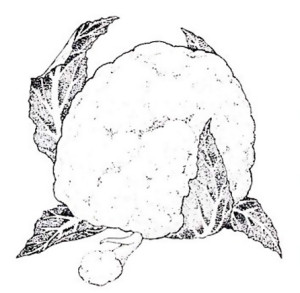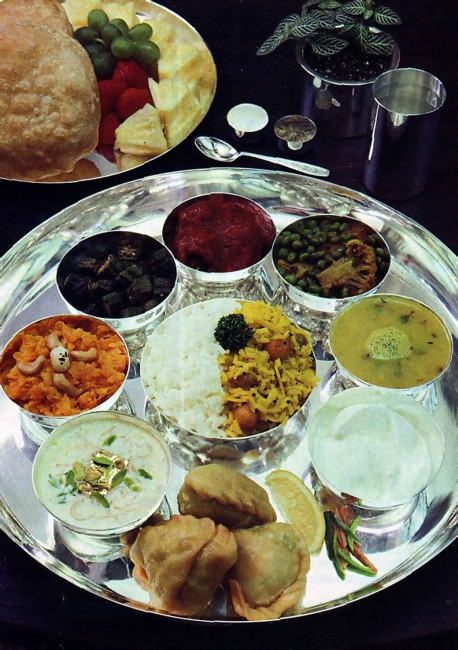The Best from Any Angle
Vegetarianism has many advantages.
“Prasadamism” goes a step a further
by Visakha-devi dasi
Whether you look at Lord Krsna’s cuisine from the viewpoint of taste, health, economics, morality, or spiritual benefit, it’s our firm conviction that it’s the best in the world.
In Eating for the Eighties, authors Janie and Neil Hartbarger begin by saying, “Nature provides us with a complete diet. As long as we use it wisely, not playing with food too much, stripping it of nutritional value in our attempts to improve it, that abundance can feed us well and keep us healthy. As we will show, there’s no need to include meat. It is variety that balances everything out…. Complex carbohydrates should be the mainstay of your diet.” This is like a summary of our Krsna conscious diet. Today’s packaged, precooked convenience foods don’t find their way to Krsna’s offerings. We offer Krsna dishes made from whole grains, nuts, vegetables, fruits, and milk products. And the mainstays of our diet are rice, dal (made from legumes), and capatis (made from whole wheat flour)—the complex carbohydrates that the Hartbargers mentioned.
In early 1983 I read a report from the American Institute for Cancer Research. Eating meat (as well as drinking coffee or alcohol), the report warned, is likely to cause cancer. The Institute recommends eating fresh fruits and vegetables to help reduce the risk. As you may know, in Krsna consciousness we don’t eat meat, nor do we drink any alcohol or coffee. Long before these studies of cancer-causing foods were made. Lord Krsna gave us some simple principles to protect our health as: well as to help us advance spiritually.
As for variety, well just look at the photograph and say there’s no variety in the vegetarian cuisine! And just think, there are some sixty types of vegetables, eleven types of legumes, fifty types of fruits, forty different spices, as well as a variety of nuts, grains, and dairy products, all of which can be prepared in innumerable ways by varying the combinations of ingredients, the cooking methods, spicing, and so on. If you calculated all the possible varieties mathematically, you’d be flabbergasted.
Now for the economics of it. To get the total amount of the recommended daily allowance of usable protein that the average American male needs (43.1 grams), you’d need to buy thirty-five cents’ worth of split peas. To get the same amount of protein from steak would cost you two dollars. But who needs statistics? Anyone who looks at the supermarket prices knows that meat’s an expensive source of protein. And it’s expensive in terms of world economics as well. Frances Moore Lappe writes, “An acre of cereals can produce five times more protein than an acre devoted to meat production; legumes (beans. peas, lentils) can produce ten times more; and leafy vegetables fifteen times more.”
As for morality—don’t forget about the suffering of the millions upon millions of innocent animals that are slaughtered yearly to fill our stomachs. Unfortunately, we have been forgetting. But the suffering due us as a result of our sins won’t be forgotten, and today’s animal killers will suffer horribly in future lives. That is the law of nature.
And who are those animal killers’.’ “When animals are killed in the slaughterhouse,” Srila Prabhupada explains, “six people connected with the killing are responsible for the murder. The person who gives permission for the killing, the person who kills, the person who helps, the person who purchases the meat, the person who cooks the flesh, and the person who eats it, all become entangled in the killing.”
Now you might think you’d like to become a vegetarian. But why stop there? We’re offering something much better. Lord Krsna’s cuisine is much more than vegetarianism. It’s prasadamism. You could say, “What is this prasadam? We’re eating the same food. Why is it called prasadam? You might think it’s just ordinary food, but because it has been offered to Lord Krsna, it is now His mercy (prasadam). It has been spiritualized.
Will you like the way prasadam tastes? Well, we can’t guarantee that you’ll like every dish; but then again, maybe you will. The best way to find out is to try it. As it’s said, the proof of the pudding is in the eating.
(Recipes by Yamuna-devi dasi)
Sauteed Cauliflower and Green Peas
(Phoolgobi-Mattar Sabji)
Preparation time: 45 minutes
Servings: 4
4 tablespoons vegetable oil or ghee (clarified butter)
½ tablespoon peeled fresh ginger root, minced fine
1 ½ teaspoons cumin seeds
8 to 10 small sweet nim leaves, if available
1 large cauliflower, trimmed, washed, and cut into small flowerettes about 1 ½ inches long and ½ inch wide
1 teaspoon turmeric powder
1/8 to ¼ teaspoon chili powder or paprika
1 teaspoon salt
1 cup green peas
2 tablespoons fresh coriander or minced parsley leaves
¼ cup heavy cream, homemade cultured sour cream, or plain yogurt
1. Heat the ghee in a 4- to 5-quart saucepan over a medium flame for 1 minute. Stir in the minced ginger root and cumin seeds and fry until nicely browned. Stir in the sweet nim leaves and then add the cauliflower flowerettes. Sprinkle with turmeric, salt, and chili powder or paprika. Stir-fry until the cauliflower is slightly browned and partially cooked. Add the peas and about 2 tablespoons water. Cover and reduce the flame to low. Cook for about 15 minutes, stirring occasionally, until the vegetables are tender but not broken down. Remove the lid, raise the flame, and cook until dry.
2. Fold in the cream, sour cream, or yogurt and sprinkle with fresh parsley or coriander leaves. Then offer to Krsna.
Deep-Fried Cauliflower Balls in Tomato Gravy
 (Phoolgobi Kofta/ Tomatar Sas)
(Phoolgobi Kofta/ Tomatar Sas)
Preparation time: 1 ¼ hours
Servings: 4 or 5
Ingredients for cauliflower balls:
3 cups firm white cauliflower, grated
½ tablespoon fresh ginger root, minced fine
1 teaspoon hot green chilies, minced fine
3 tablespoons fresh coriander or minced parsley leaves
1 teaspoon turmeric powder
1 ½ tablespoons coriander powder
1 tablespoon dry-roasted cumin seeds, crushed coarse
1 cup chick-pea flour
1 teaspoon baking powder
¾ teaspoon salt
3 cups ghee or vegetable oil for frying
1. Combine the grated cauliflower, ginger root, chilies, fresh minced herbs, turmeric, coriander, and cumin seeds in a 2-quart mixing bowl; toss to blend the ingredients well. In a smaller bowl, thoroughly mix the chick-pea flour, baking powder, and salt.
2. Begin to heat the clarified butter to 350 °F over a medium flame in a 10- to 12-inch wok or deep-frying pan. Meanwhile, add the flour to the grated cauliflower and mix with your hand until the ingredients hold together. Immediately divide the mixture into 12 balls.
3. Deep-fry 6 balls at a time, turning frequently and maintaining the temperature between 320° and 330° for 8 to 12 minutes, or until the balls are a deep reddish color. Remove the balls from the ghee with a slotted spoon and drain on absorbent paper.
Ingredients for tomato gravy:
2 pounds tomatoes, cut into quarters
6 blanched almonds, chopped
1 tablespoon sesame or white poppy seeds
¼ cup fresh coriander or minced parsley leaves
1 teaspoon hot green chilies, minced fine
1 tablespoon coriander powder
1 teaspoon cumin powder
¼ cup ghee or vegetable oil
½ tablespoon fresh ginger root, minced fine
1 teaspoon black mustard seeds
1 tablespoon sugar or honey
1 ½ teaspoons salt
1. Combine the tomatoes with 1 cup water in a 2-quart saucepan. Place on medium flame and simmer, partially covered, for 15 minutes. Remove the pan from the heat, cool for 10 minutes, then pour the ingredients through a sieve, a little at a time, until allot the tomato puree is collected in a bow] and only the skins, membranes, and seeds remain in the sieve; set aside puree while preparing the paste spice.
2. Place the chopped almonds and sesame or poppy seeds in an electric coffee mill and pulverize until powdered. Transfer the powder to an electric blender jar, add ½ of the fresh coriander, ginger root, and chilies and 1/3 cup water; cover and blend at high speed until the ingredients are reduced to a smooth puree. Pour the puree into a small bowl and stir in the powdered coriander and cumin.
3. Heat the oil or ghee in a 3-quart saucepan over a medium flame until a drop of water flicked into it instantly sputters. Drop in the mustard seeds and the sweetener, and fry until the mustard seeds crackle and the sweetener reddens. Stir in the spicy puree and enough water to yield 3 ½ cups of liquid. Add the salt and remaining fresh herbs and simmer the sauce until it is reduced to 2 ½ or 3 cups.
4. Add the balls to the simmering gravy, letting them soak for only 4 to 5 minutes before offering to Krsna.
Deluxe Yellow Split-Pea Soup
(Arhar Dal)
Preparation time: 30 minutes
Servings: 5 to 6
¾ cup arhar dal, unoiled, or yellow split peas
4 cups water
1 teaspoon peeled fresh ginger root, minced fine
½ teaspoon hot green chilies, minced fine
2 ½ tablespoons fresh lemon or lime juice
1 or 2 dried cassia or bay leaves
½ teaspoon turmeric powder
¼ to 1 teaspoon salt
2 ½ tablespoons ghee or vegetable oil
1 teaspoon cumin seeds
1/8 teaspoon fenugreek seeds
1/8 teaspoon mild asafetida powder
1 teaspoon black mustard seeds
2 teaspoons sugar or mild honey
1. Clean, wash, and drain the dal or split peas.
2. Place the washed dal or split peas, water, ginger, chilies, lemon juice, cassia leaves, turmeric, salt, and ½ tablespoon ghee in a heavy saucepan and bring to a boil over a high flame. Reduce flame to medium, cover, and gently boil, stirring occasionally, for about 1 hour, adding water if necessary, or until the dal or split peas are mushy and soft. Remove from the flame, pick out the whole cassia leaves, and whip the dal or split peas with a rotary beater until creamy smooth.
3. Heat the ghee in a small pan over a medium flame. One after another, stir in the cumin seeds, fenugreek seeds, and black mustard seeds. Fry until the seasoning begins to brown. Add the asafetida powder and sweetener. Stir and cook until the sweetener turns red. Remove from the flame and pour into the cooked dal or split peas. Cover and allow the spices to seep into the soup for one or two minutes. Stir and offer to Krsna.


Leave a Reply